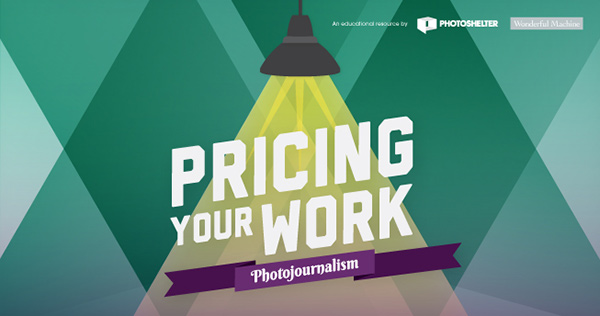Share
Pricing Your Work, Tip #1: Fees & Terms to Expect as a Photojournalist
This is the first in a series of blog posts exploring pricing your work from our 3 free guides written with Bill Cramer, CEO of Wonderful Machine....

This is the first in a series of blog posts exploring pricing your work from our 3 free guides written with Bill Cramer, CEO of Wonderful Machine. We’ll be sharing tips via the blog this week on how to price your magazine photography, corporate & industrial photography, and photojournalism. Get the guide Pricing Your Work: Photojournalism here.
You’ve met with a photo editor and they love your pictures. The next thing you know, they’re calling you with an assignment. Great! But along with that assignment will come a contract. Every client will have their own expectations about what they’ll want to pay and what rights they expect to get for that payment. So it’s a good idea to learn a bit about this process in advance, so you can handle yourself appropriately when that time comes. Here are a few questions you’ll want to ask yourself (or the client).
What is the fee for an assignment? Is it the same whether it’s 10 minutes or 10 hours?
It’s customary for the assignment fee to cover up to a certain number of hours (sometimes 4, sometimes 8 hours), then pay extra if the assignment runs longer than that. We see assignment fees ranging from $75.00 flat to $600.00 plus expenses. Many publications pay what’s called a “day rate.” How long a day is, is sometimes vague. And it’s up to you to decide how clear you need to be with your client.
What expenses is the client covering?
Some clients pay a flat fee which includes any expenses. Others pay a fee plus incidental expenses like mileage, tolls, parking. Still others pay those incidental expenses, plus fees for digital delivery (which might be 100.00 – 500.00 for a web gallery and reproduction file processing). Some portrait or conceptual assignments may require assistants (150.00 – 300.000/day) and lighting equipment rental (300.00 – 500.00/day).
What rights does the client get (licensing)?
The assignment fee should be commensurate with the usage. The more rights they have to your pictures, the more valuable they are to the client, and the more you should be paid.
One-time editorial print use and concurrent web use is what every publication will want, at a minimum. At this point, every publication publishes on some combination of platforms (whether it’s print, online, or tablet), so there’s no point in trying to negotiate separately for them.
Other publications will also want to re-use your pictures without additional payment, so that’s worth a bit more.
Some publications will want to license your pictures to unknown third parties, which I do not recommend for any price that they would be willing to pay.
Worst of all, some clients will insist on Work Made For Hire, which means that the client owns all the rights to your photos (including the right to license them to third parties), and you have no rights (except possibly to use the pictures in your portfolio). At Wonderful Machine, our rule of thumb is that we don’t consider WFH agreements for fees under $10,000.
What rights does the photographer retain (exclusivity)?
It’s important to understand the difference between licensing and exclusivity, as they can be independent of each other. Licensing refers to how a client can use your photos (the license that you are conveying to them in exchange for a fee), and exclusivity refers to how the photographer can use the photos. It’s not uncommon for a client to place an embargo on the pictures for a certain period of time after they are first shot or first published. That’s reasonable for a period of a few weeks, but a photographer needs to be able to license the pictures to other publications if he/she is going to make a decent living. All photojournalists need to have a plan to relicense important pictures (whether it means marketing them themselves or working with a picture agency). It’s common courtesy to allow the publication to publish the photos before you show them to anyone else (especially the subject). But most clients won’t mind you using the photos in your portfolio, after they’ve been published, even if it’s within the embargo period.
What if the client wants to re-use a picture that you shot for them, or if they want to use a picture that you shot for someone else?
Re-use is generally something that every contract will cover. Some clients pay for one- time use and then pay an additional fee if they use the pictures again. Other clients want to be able to use the pictures again without additional payment (which is fine if the original payment is enough). And some clients even want to be able to license your photo to third parties without additional payment (which I would not accept without negotiating a separate payment).
If a client wants to re-use of a picture you shot for them in their own publication, that’s one thing. But if they want to use a picture of yours that was not originally shot for them, then that should be negotiated on a case-by-case basis. Stock use of an ordinary picture is generally worth about the same as a typical assignment fee or a little less. So if a publication pays $200 for an assignment, then I’d want to get about $150 for a stock picture. Just be clear with the client that it’s for one-time use and that the terms of their assignment contract don’t apply to that picture. If it’s an extraordinary picture that they can’t get anywhere else, it could be worth $1k, $10k, or $100k depending on how special it is.
What types of insurance will you need?
As a freelance photojournalist (or independent contractor) who doesn’t receive benefits from an employer, you’ll need to get your own equipment insurance and liability insurance. Liability insurance covers you in the event that you drop a lens on someone’s head or they trip over your light stand or you put your boom arm through their Picasso. There are some buildings that you won’t be able to shoot in unless you can provide proof of insurance (called a certificate of insurance). Many contracts say that you will “indemnify and hold harmless” your client if they get sued because of something you did. Make sure your liability insurance covers that, too (which is sometimes called an “errors and omissions” clause).
I also recommend that you have health insurance and disability insurance. If you’re married or have kids, you will need life insurance. If you’re over 50, you’ll need long- term care insurance.
Let’s get started with tips for pricing your photojournalism, you can get the guide here:





